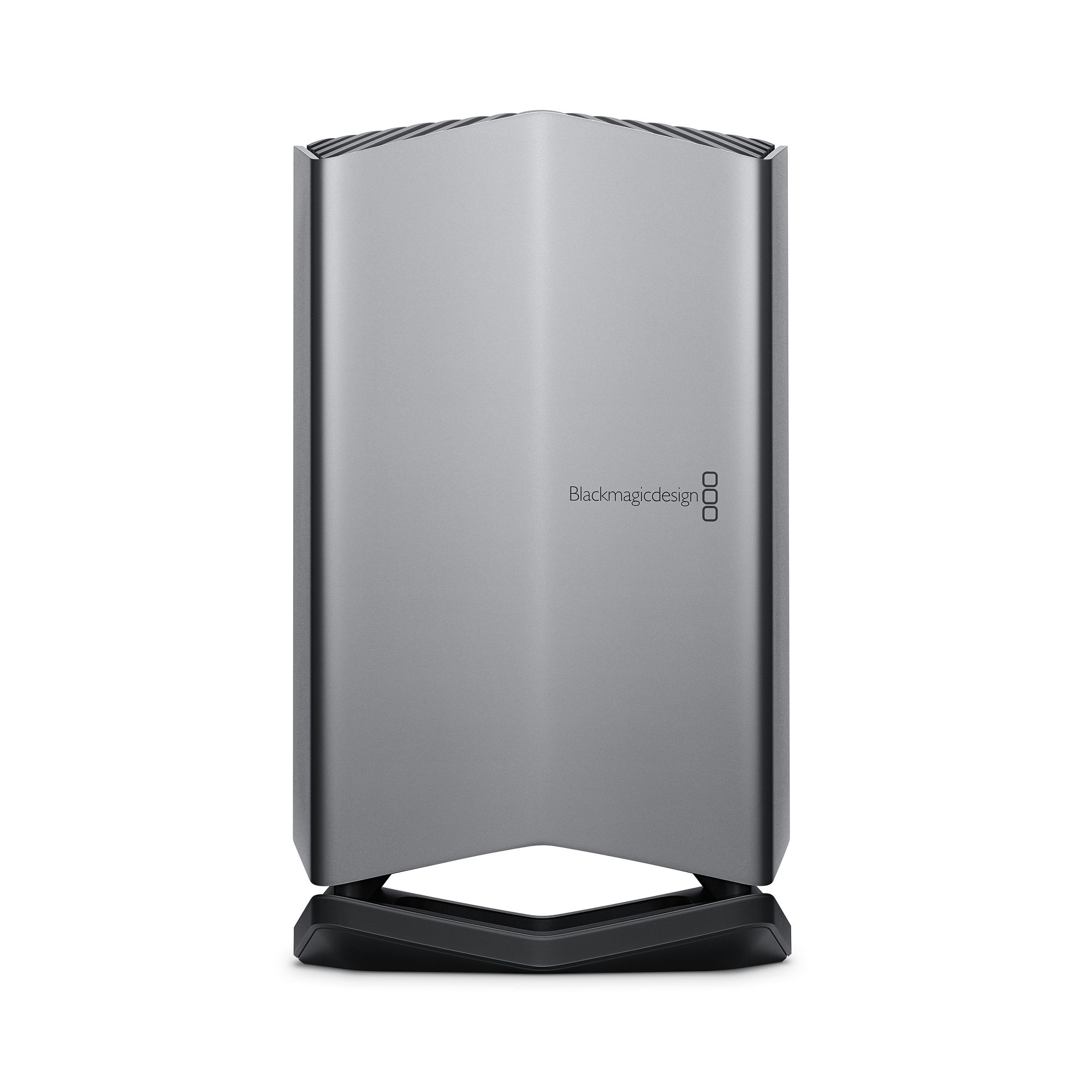-
The Blackmagic Design eGPU has a sleek, simple design.Samuel Axon
-
You could use it as a Thunderbolt and USB dock, if you wanted.Samuel Axon
-
Heat is pushed out through vents on the top.Samuel Axon
-
The full package: a MacBook Pro with Apple's sanctioned eGPU, and Apple's sanctioned external monitor (an LG UltraFine display).Samuel Axon
-
There's nothing to see on the side; let's call it "clean."Samuel Axon
Is the eGPU the future of Mac graphics? Apple wants you to think so, and, for the first time, it has worked with an outside firm (Blackmagic Design) to produce a sanctioned eGPU solution for the Mac. Simply titled the Blackmagic Design eGPU, it's available for $699 exclusively through the Apple Store.
It includes a Radeon Pro 580 GPU with 8GB of GDDR5 memory, two Thunderbolt 3 ports, four USB-3 ports, and one HDMI 2.0 port—and it's only compatible with Macs with Thunderbolt 3 ports. When Apple first mentioned this product, it claimed that it's easier to set up, quieter, and smaller than most existing external GPU enclosures.We spent some time with that enclosure and found it to be exactly what Apple and Blackmagic say it is. It's an improvement over the discrete or integrated GPUs in all of Apple's laptops, but it's not as powerful as a modern desktop workstation, a high-end Windows gaming PC, or the iMac Pro. And while Apple is making some welcome improvements to eGPU support in macOS Mojave (due out this year), there are still some disappointing limitations, like a lack of support for Windows in Boot Camp.
The biggest downside to this product, though, is that the GPU in the Blackmagic enclosure is not upgradeable. Here's the quick review.
Design
The Blackmagic Design eGPU is one solid tube—in fact, it might remind you of the "trash can" Mac Pro Apple launched several years back. This one's not cylindrical, though—it has eight sides. The whole enclosure measures at 11.59×6.96×6.96 inches, and it's somewhat heavy at 9.92lbs. You won't be carrying it around on an airplane, but that wasn't the idea here; the goal was just to keep it from taking up too much space as it sits permanently on your desk.

Blackmagic Design eGPU
There are vents on the top to let the hot air out, and there's a subtle stand beneath the main enclosure. Turn off the lights in the room, and you'll see that it projects a light inside the stand at the bottom. It's a cool-looking effect that's not too over the top, but it wasn't necessary.
On the back, you'll find an impressive array of ports. There are four USB-3 Type A ports, two Thunderbolt 3, an HDMI 2.0 port, and a place to plug in the power cord. The power cord measures in at 1.8 meters, and the enclosure comes with a half-meter Thunderbolt 3 cable. You can plug that one cable into your Mac and use it to power the Mac (85W), then plug USB peripherals into the enclosure. That means this actually works as a USB hub, which adds to the value proposition here.
When we first heard about this enclosure, Apple said it had a smaller footprint and was quieter than most other options. The footprint is indeed small, though the enclosure is much taller than all of the others we've used. We can confirm that Apple wasn't kidding about the noise level—we measured it at exactly the promised 18db when under load. In other words, it's barely audible at all. Some other eGPU enclosures are quite loud.
The two Thunderbolt 3 ports and 85W power delivery make this an easy-to-set-up solution. Plug one Thunderbolt 3 cord into the MacBook Pro and plug another into an external display, and you're done. Apple's macOS instantly recognizes it, and, in High Sierra, it's the default GPU in most applications that can use it while you're in clamshell mode with an external display. No further setup is required. You'll just want to eject it before unplugging it like you would with an external hard drive.
External GPUs in macOS Mojave
That's how it works in High Sierra. We also tried this enclosure with the latest macOS Mojave beta, which offers some nice improvements to the eGPU experience. First of all, powering the built-in display is now supported. (It's not in High Sierra; you have to work in clamshell mode with an external display to take advantage of any eGPU in the current public release of macOS.)More importantly, though, you can force any application to use the eGPU instead of the integrated or discrete graphics in your Mac. This solves one of the biggest frustrations I had when I previously reviewed an eGPU enclosure with macOS High Sierra 10.13.4—certain applications just wouldn't use the eGPU, even if they could benefit from it.
This was technically possible to do using the Terminal before, but not everyone would be keen to do it that way. Now you can do it by just clicking "Get Info" on an application in Finder and clicking a single check box.
-
To force external GPU usage for an app, first you have to select "Get Info" with the app selected in Finder.Samuel Axon
-
Then you'll find a "Prefer External GPU" option in the panel.Samuel Axon
There are still some key things missing for eGPU users even in Mojave, though. Support for Windows in Boot Camp and Nvidia graphics cards is missing—also, note that you need a Thunderbolt 3 port, so older Macs just won't work.
Next up: performance.
reader comments
230